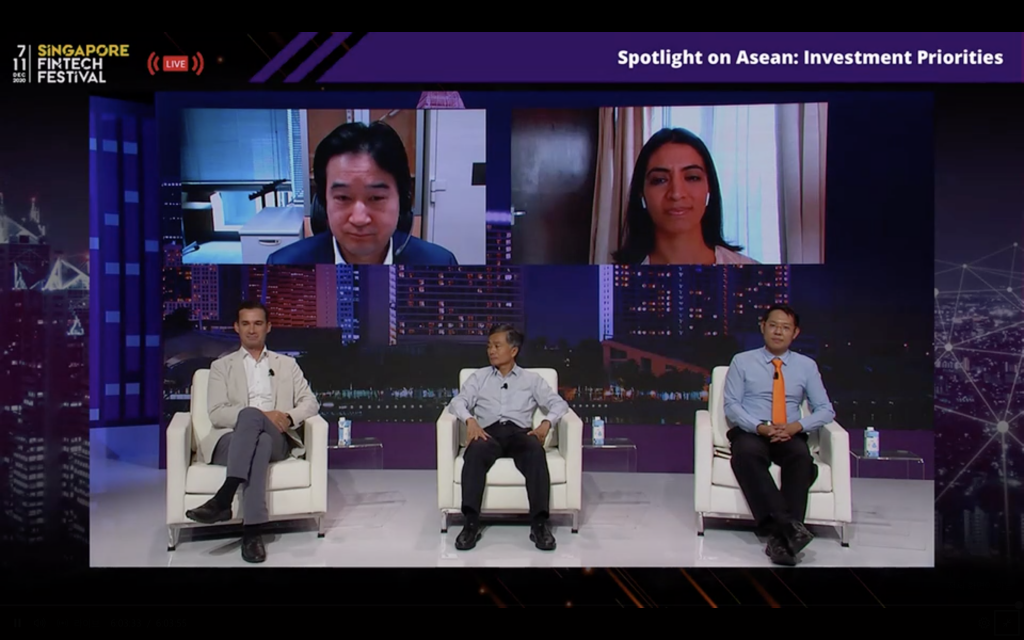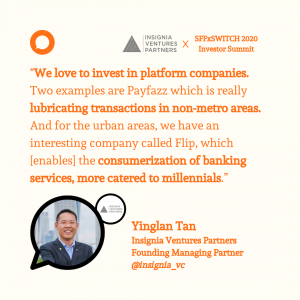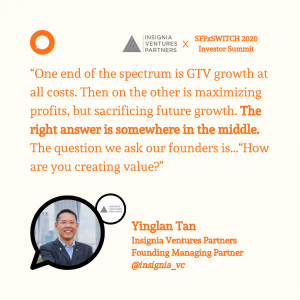Last December 10, our founding managing partner Yinglan Tan joins the opening panel for the investor panel of SFFxSWITCH 2020, “Spotlight on ASEAN: Investment Priorities”, alongside SBI Investment Executive Officer for Overseas Investment Tomoyuki Nii, Sixteenth Street Capital founder Rashmi Kwatra, Beenext Managing Partner Dirk Van Quaquabekea, and Qualgro Partners founding managing partner Heang Chhor. The panel was moderated by EY Global Emerging Markets Fintech Leader Varun Mittal and Expand Research Managing Director and Head of Asia Pauline Theobald Wray.
Highlights
- Fintech will be at the forefront of investing in Southeast Asia, in the next ten years.
- Fintechs are becoming more competitive as they capture more and more of the banking experience, presenting a concentration of risk (i.e. dependency) at the top of the competitive landscape.
- Investors are closing in on winners across industries, and for fintechs that means becoming “omnipresent” for customers — whether this will be achieved purely from a platform play with existing ecosystems or adoption of new infrastructure like blockchain remains to be seen.
- Achieving real growth means thinking long-term, achieving the right balance between profitability scale, something that can only be achieved by creating real value for customers.
- Making meaningful, landmark exits in Southeast Asia will take time given the lack of expertise (in IPOs for example) and lack of avenues.
By 2030, ASEAN is predicted to reach 4.3 trillion USD GDP, becoming the sixth-largest economic bloc in the world. In the next ten years, ASEAN will play a greater role as a destination for global talent and capital in the next decade, with its geopolitical positioning as a bridge between the East and West, and its massive economic growth potential, especially in the digital economy.
The tech, startup, VC landscape in the region, or ASEANnovation, will be a driving force to accelerate adoption for the internet’s next 600+ million users in the region. In this regard, investors play a key role in supporting founders as they navigate ASEANnovation.
Apart from the monetary gains to be made from the region’s relatively rapid economic growth, what drives investors to invest in Southeast Asia is ultimately the impact and value that can be made in the region. “[Investing] boils down to the delta and the impact you can drive in this part of the world,” says Beenext’s Dirk Van Quaquabeke.
And over the past ten years, the grounds for potential impact have shifted. What began as the sharing economy (Grab, Gojek) and ecommerce marketplaces (Sea, Razer, Lazada, Tokopedia) have now evolved into new areas driven by the changing needs of consumers as they become more active online, from logistics to financial services.
Fintech at the forefront of ASEANnovation’s next decade
In the next ten years, the digitalization of financial services, in particular, will be at the forefront of ASEANnovation. We’ve already seen this year marked by the movement of tech unicorns and giants into the fintech space through payments (GrabPay, GoPay, ShopeePay) and banking licenses. Consumers are looking for more “complete” customer journeys on their fintech apps and the digitization of businesses along supply chains means more data to power B2B financial transactions.
Dirk Van Quaquabeke talks about this excitement around the financial inclusion impact that could be made with the digitalization of financial services. “When we think about the excitement in this part of the world and the delta we can create it’s a lot larger than developed countries in making money [more] present [in the lives of consumers]…”
Qualgro’s Heang Chhor sees two types of fintechs emerging: the digital financial service platforms and the technology enablers. “There’s a growing demand for digital financial services in the pandemic…cohort of founders [will] build great companies in fintech wealth management, payments, or tech-based companies providing software, AI, data platforms for large FIs.”
“When we think about the excitement in this part of the world and the delta we can create it’s a lot larger than developed countries in making money [more] present [in the lives of consumers]…” – Beenext Managing Partner Dirk Van Quaquabeke

SFFxSWITCH 2020 Investor Summit Panel “Spotlight on ASEAN: Investment Priorities”, with (L-R, top to bottom): SBI Investment Executive Officer for Overseas Investment Tomoyuki Nii, Sixteenth Street Capital founder Rashmi Kwatra, Beenext Managing Partner Dirk Van Quaquabeke, Qualgro Partners founding managing partner Heang Chhor, and Insignia Ventures Partner founding managing partner Yinglan Tan. The panel was moderated by EY Global Emerging Markets Fintech Leader Varun Mittal and Expand Research Managing Director and Head of Asia Pauline Theobald Wray
New waves of fintechs, concentration at the top, misconceptions, missed opportunities: Risks for fintechs
For Yinglan, the immense opportunity for fintechs has also been met with risk. “The first wave of fintechs were unbundling the bank, but then they realized there are regulatory requirements and high acquisition costs, and difficulty in retaining customers.”
But then this risk for the first wave of fintechs is also now being overcome with new fintech models. “…now we’re seeing the second wave, which is the rebundling of the banks, we see it in tonik in the Philippines, and Flip and Payfazz in Indonesia.”
And as more fintechs enter the playing field, introduce more holistic services, and dominate consumer wallets and business accounts, Dirk points out that there’s also the risk of dependency (from the customer perspective) on the top players. “In fintech, the top consolidates power. Ultimately there will be seismic risks in 10 years. It’s really a concentration of risk.”
And investors are trying to cash in on the race, but SBI Investments’ Tomoyuki Nii notes that “People investing in the region sometimes do not understand the fragmentation in the region.” This fragmentation can easily affect how certain local fintech champions may have a harder time expanding cross-border versus regional tech companies that are not necessarily fintechs but already have the customer base to adopt new financial services on their platforms.
The fragmentation also means that certain needs for fintechs to grow may not be met, according to Heang. “The main risk isn’t so much the regulations. The main risk for me is the missed opportunities. The missed opportunities of not having the right expertise to help fintechs or missed opportunities in not providing the right infrastructure to the non-metro areas…”
“The main risk isn’t so much the regulations. The main risk for me is the missed opportunities.” – Qualgo Partners Founding Managing Partner Heang Chhor
Investors closing in on winners, so what does it mean to win the fintech space in Southeast Asia?
In spite of these risks, tech investors continue to see fintech coming out of this year stronger, with many fintech sectors boosted by COVID-induced digital adoption. That said, equity funding into fintechs is not equal across the board. More of the interest has been going towards mid and mature fintechs, with 65% of equity funding going into a selected few fintech players.
This isn’t a phenomenon necessarily confined to fintech. Given the expected K-shaped recovery of the global economy coming out of the pandemic, with winners coming out stronger than ever before and badly hit players forced to close shop or rethink strategy, there will be greater consolidation of capital around emerging local and regional champions in ASEAN. With more growth-stage investors entering the playing field, there is greater motivation for early-stage investors to drive selected portfolio companies towards sizable exits.
This now begs the question, what does it mean to be a champion in Southeast Asia’s fintech space?

For Dirk, it will be a race “to enable…the omnipresence of money — creating platforms that enable payments as well as financial products in a way that is consumable and embeddable through APIs in a captive product that owns the consumers.”
And there are many paths to this “finish line”. “Are we going to get there first from unbundling and rebundling of the existing ecosystems or do we get there first by a broader adoption of cryptocurrencies?” Dirk adds.
Yinglan, in particular, believes in the scalable impact of platform companies, pointing out how two companies have enabled banking of the unbanked and consumerization of banking services in Indonesia.
“We love to invest in platform companies. Two examples are Payfazz which is really lubricating transactions in non-metro areas. We’ve [also] done a lot of co-investments with them. And for the urban areas, we have an interesting company called Flip, which allows consumers to transfer money for free…the consumerization of banking services, more catered to millennials.”
Achieving real growth means creating real value
To become a winner in Southeast Asia’s fintech space — or any industry for that matter — founders need to pin down “real” growth.
Real growth is long-term. According to Sixteenth Street Capital’s Rasmi Kwatra, “we advise our founders to think long-term. ASEAN [as a region] offers us opportunities to think long-term…”
Real growth is making profits. As Tomoyuki puts it, “My advice to founders is to make profits, not just keep the topline…Without profits, startups will not be able to survive in the mid-term and long-term.”

Real growth is about striking the balance between growth at all costs and maximizing profits. “There’s two way to think about it. One spectrum is transaction growth or GTV growth at all costs. Then on the other extreme is maximizing profits, but maybe sacrificing future growth. The right answer might be somewhere in the middle,” says Yinglan.
And at the heart of striking this balance — and achieving real growth — is ultimately creating real value. “The question we ask our founders, “How are you creating value?” adds Yinglan.
“My advice to founders is to make profits, not just keep the topline…Without profits, startups will not be able to survive in the mid-term and long-term.” – SBI Investments Executive Officer for Overseas Investments Tomoyuki Nii
Investors gearing up for exits, but it will take time
And this creation of real value and achieving real growth aligns with investor interests, in spite of the gold rush in the last three to five years that has incentivized inefficient business models and overblown valuations.
Investors as whole will have learned a lot from the IPO flops in 2019 and COVID in 2020, and we can expect a stronger flight to quality companies — that is to say, companies that have healthy fundamentals, proven business models, and a path to scale and profitability.
But investing in companies early on and eventually taking them to meaningful exits are two different animals entirely. According to Dirk, “[Southeast Asia] has a lot to learn in terms of executing IPOs.” In Southeast Asia, most VCs have been “enabling that kickstarting [of companies]…but now how are we planning at scale [not only] for exits and consolidation but also to build real ivory companies that can sustain growth?”
Heang says, “There are many ways to exit, but there’s one thing we should do a bit [more] is find IPO opportunities for our companies in Southeast Asia.” That said, it may not be realistic within the next decade to expect regional exchanges to actively facilitate tech IPOs given the capacity of the market. Global IPO hotspots like NASDAQ will remain the go-to, and just like the physical from this part of the world to Wall Street, the road remains long and unequal for Southeast Asian companies to list on global exchanges.
Regional VCs are well-aware that it will take time. “Time does play a part [in exits]…you need everything to fit together, and that takes time,” says Rashmi.
“Time does play a part [in exits]…you need everything to fit together, and that takes time.” – Sixteenth Street Capital Founder Rashmi Kwatra
***
In the meantime, VCs and tech investors in the region will continue to invest in ASEANnovation, and fintechs that will be at the forefront of this digitalization rush. According to Yinglan, ASEAN as a region will play a greater role in connecting innovation across the globe, and there remain many “white spaces” for tech companies to play this role. “Given the interest from US and China in Southeast Asia, to the extent that we can profit from it, we can…we look at Sea as the benchmark, but there are a lot of white spaces in between…”
For more notes on past events, head to this page. We also cover events our team is at on our Twitter and Instagram.
Paulo Joquiño is a writer and content producer for tech companies, and co-author of the book Navigating ASEANnovation. He is currently Editor of Insignia Business Review, the official publication of Insignia Ventures Partners, and senior content strategist for the venture capital firm, where he started right after graduation. As a university student, he took up multiple work opportunities in content and marketing for startups in Asia. These included interning as an associate at G3 Partners, a Seoul-based marketing agency for tech startups, running tech community engagements at coworking space and business community, ASPACE Philippines, and interning at workspace marketplace FlySpaces. He graduated with a BS Management Engineering at Ateneo de Manila University in 2019.